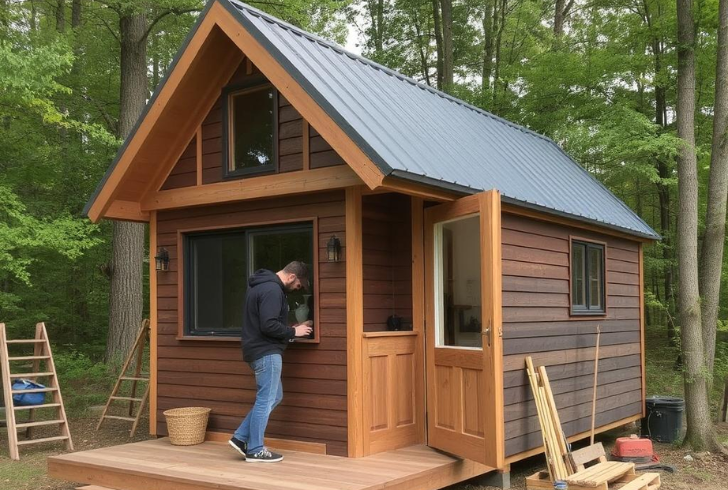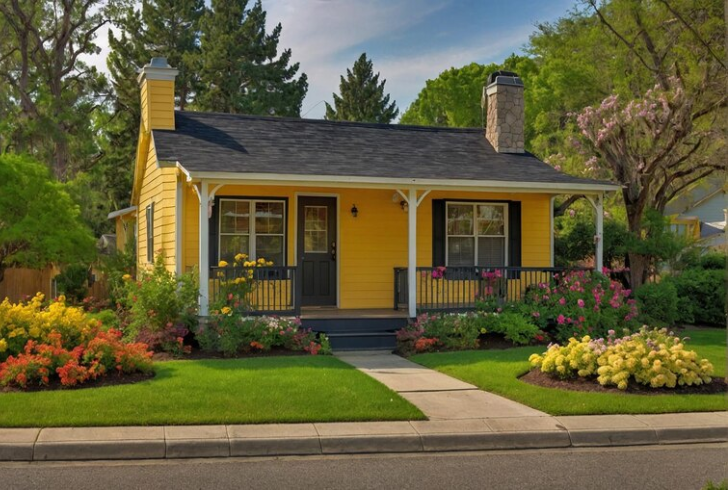What Life in a Tiny Home Really Feels Like, According to an Expert
Living in a tiny home has become a popular choice for many who want to simplify their lifestyle, reduce costs, or make the most of a small space. While the idea of downsizing may seem overwhelming, real-life experiences reveal the unique benefits and challenges of living in such a compact environment. One such story comes from Precious Price, an entrepreneur and realtor, who transformed a shed into a functional and stylish accessory dwelling unit (ADU).
Through her journey, she uncovered the realities of tiny home living, providing valuable insights for those considering this minimalist lifestyle.
Building a Tiny Home – Precious Price’s Experience

Image by Gencraft AI | Building a tiny home helped Precious Price earn extra income.
Precious Price’s tiny home adventure began in 2020 when she decided to use the large backyard of her Atlanta property to create an ADU. By converting a 12-by-24-foot shed into a fully functional “Tiny Home,” she opened up opportunities to rent her larger house and make additional income.
The project required detailed planning, including drafting floor plans and securing proper permits from the city. After a few months of work, the home was completed in March 2021, with a total cost of $35,000. Price notes that similar builds now may cost upwards of $60,000. Her experience highlights the increasing popularity of tiny homes and the financial advantages they can provide.
Downsizing Brings Simplicity
One of the biggest takeaways from Price’s time in her tiny home was the realization of how attached people are to their possessions. She observed that larger homes encourage over-consumption because there’s more space to store unnecessary items.
Living in a smaller space forced her to evaluate what she truly needed. For example, she discovered she didn’t use many beauty products she had accumulated in her larger home. By downsizing, she embraced a minimalist approach, keeping only the essentials.
She explained, “You move into a smaller space and realize, ‘I don’t even use this,’ or ‘I don’t need this.’” Her insights reflect how tiny home living can encourage mindfulness about consumption habits and material possessions.
Making Spaces Multifunctional
Maximizing functionality is crucial when designing a “Tiny Home.” Price initially worried that the open layout of her small space wouldn’t allow for a dedicated workspace. However, a clever solution came in the form of a drop-leaf table, which doubled as both a dining area and a desk.
This dual-purpose furniture allowed her to work remotely without sacrificing living space. Her approach illustrates the importance of choosing furniture that can serve multiple roles, which is often a key feature of tiny home design.
No Compromises on Kitchen or Bathroom
Despite the limited space, Price prioritized having a functional kitchen and bathroom. Her kitchen included a full-size refrigerator, a deep sink, and an induction cooktop with two burners. These essentials provided the convenience of a traditional kitchen in a much smaller footprint.
The bathroom, too, featured a full shower, a vanity, and a toilet with working plumbing. Price’s experience shows that living in a “Tiny Home” doesn’t have to mean sacrificing comfort or modern amenities.
Understanding Trade-Offs
While her tiny home offered many advantages, Price admitted there were a few trade-offs. One notable omission was the lack of a washer and dryer in the unit. She relied on the laundry facilities in her larger house, which she described as inconvenient.
This experience underscores the importance of thoughtful planning when designing a tiny home. Homeowners should evaluate their daily needs and prioritize essential features during the design process.
Cleaning Becomes Easier
Another benefit of living in a “Tiny Home” is the minimal time needed to clean and maintain the space. Price noted that a deep clean of the entire home took just 40 minutes.
By contrast, cleaning her larger home required much more time and occasionally prompted her to hire professional cleaners. The simplicity of tiny home living allowed her to reclaim time and save money on cleaning services.
Keeping Track of Belongings
One surprising advantage of tiny home living is how easy it becomes to keep track of items. In a smaller space, everything remains within reach. Price explained, “I didn’t leave anything in another room—there is no other room.”
This level of organization and convenience often appeals to those who value efficiency in their daily routines. With fewer belongings and less space to navigate, homeowners can avoid the frustration of misplaced items.
Visitors Are Often Surprised
Price shared that guests are frequently amazed by how spacious her “Tiny Home” feels despite being only 300 square feet. From the outside, the home resembles a shed, but the interior offers the comfort and aesthetics of a traditional house.
Visitors often comment on how well the space utilizes its layout and design. The thoughtful arrangement of essential elements makes the home feel larger than its actual size.
Outdoor Space Expands the Living Area

Image by awaiskhan7174 on freepik | Adding a porch expanded the tiny home’s living area.
Adding outdoor features, such as a porch, proved to be a significant upgrade for Price’s tiny home. The porch extended her living space and provided an area for relaxation and entertaining guests.
“Using outdoor space makes the habitable area feel much bigger,” she explained. Whether enjoying breakfast on the porch or hosting friends around a fire pit, the outdoor area enhanced her overall experience.
For those considering tiny home living, utilizing outdoor space creatively can make a significant difference in how functional and welcoming the home feels.
Why Tiny Home Living Appeals to Many
Tiny homes offer a range of benefits, from lower living costs to a simpler, more intentional lifestyle. Precious Price’s experience showcases the practicality and charm of these compact dwellings.
Her insights reveal that with thoughtful design, a “Tiny Home” can provide comfort, functionality, and even room for personal touches. While there are trade-offs, such as limited laundry facilities, the advantages often outweigh the challenges.
For anyone exploring the idea of living in a tiny home, her journey serves as a helpful guide. From downsizing to clever design choices, these homes offer an opportunity to embrace simplicity without sacrificing convenience.